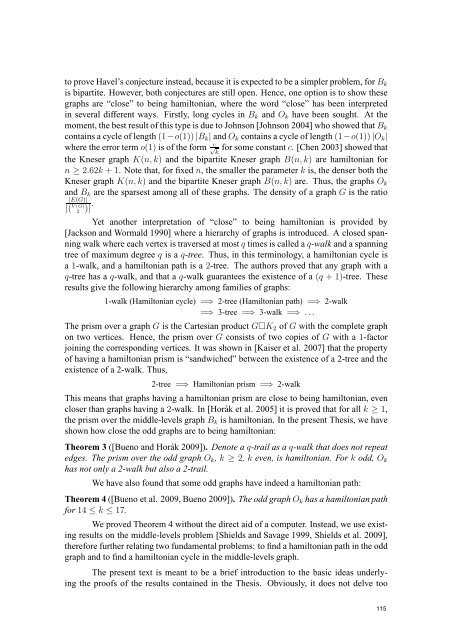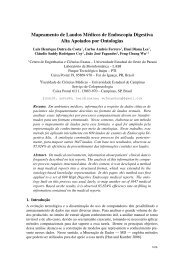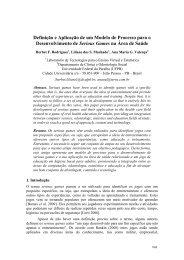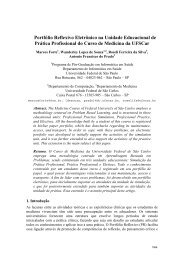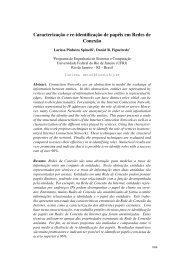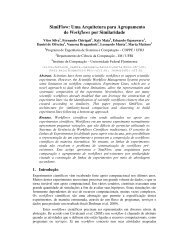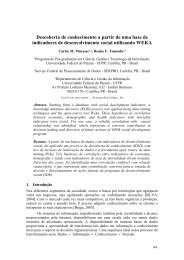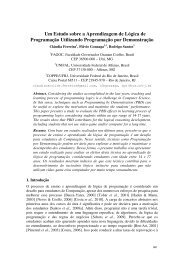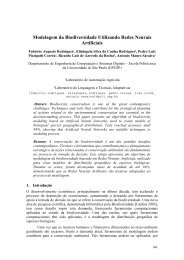Hamiltonian Cycles in Kneser Graphs
Hamiltonian Cycles in Kneser Graphs
Hamiltonian Cycles in Kneser Graphs
You also want an ePaper? Increase the reach of your titles
YUMPU automatically turns print PDFs into web optimized ePapers that Google loves.
to prove Havel’s conjecture <strong>in</strong>stead, because it is expected to be a simpler problem, for B kis bipartite. However, both conjectures are still open. Hence, one option is to show thesegraphs are “close” to be<strong>in</strong>g hamiltonian, where the word “close” has been <strong>in</strong>terpreted<strong>in</strong> several different ways. Firstly, long cycles <strong>in</strong> B k and O k have been sought. At themoment, the best result of this type is due to Johnson [Johnson 2004] who showed that B kconta<strong>in</strong>s a cycle of length (1−o(1)) |B k | and O k conta<strong>in</strong>s a cycle of length (1−o(1)) |O k |where the error term o(1) is of the form √ ckfor some constant c. [Chen 2003] showed thatthe <strong>Kneser</strong> graph K(n, k) and the bipartite <strong>Kneser</strong> graph B(n, k) are hamiltonian forn ≥ 2.62k + 1. Note that, for fixed n, the smaller the parameter k is, the denser both the<strong>Kneser</strong> graph K(n, k) and the bipartite <strong>Kneser</strong> graph B(n, k) are. Thus, the graphs O kand B k are the sparsest among all of these graphs. The density of a graph G is the ratio|E(G)||( V (G)2 )|Ẏet another <strong>in</strong>terpretation of “close” to be<strong>in</strong>g hamiltonian is provided by[Jackson and Wormald 1990] where a hierarchy of graphs is <strong>in</strong>troduced. A closed spann<strong>in</strong>gwalk where each vertex is traversed at most q times is called a q-walk and a spann<strong>in</strong>gtree of maximum degree q is a q-tree. Thus, <strong>in</strong> this term<strong>in</strong>ology, a hamiltonian cycle isa 1-walk, and a hamiltonian path is a 2-tree. The authors proved that any graph with aq-tree has a q-walk, and that a q-walk guarantees the existence of a (q + 1)-tree. Theseresults give the follow<strong>in</strong>g hierarchy among families of graphs:1-walk (<strong>Hamiltonian</strong> cycle) =⇒ 2-tree (<strong>Hamiltonian</strong> path) =⇒ 2-walk=⇒ 3-tree =⇒ 3-walk =⇒ ...The prism over a graph G is the Cartesian product G□K 2 of G with the complete graphon two vertices. Hence, the prism over G consists of two copies of G with a 1-factorjo<strong>in</strong><strong>in</strong>g the correspond<strong>in</strong>g vertices. It was shown <strong>in</strong> [Kaiser et al. 2007] that the propertyof hav<strong>in</strong>g a hamiltonian prism is “sandwiched” between the existence of a 2-tree and theexistence of a 2-walk. Thus,2-tree =⇒ <strong>Hamiltonian</strong> prism =⇒ 2-walkThis means that graphs hav<strong>in</strong>g a hamiltonian prism are close to be<strong>in</strong>g hamiltonian, evencloser than graphs hav<strong>in</strong>g a 2-walk. In [Horák et al. 2005] it is proved that for all k ≥ 1,the prism over the middle-levels graph B k is hamiltonian. In the present Thesis, we haveshown how close the odd graphs are to be<strong>in</strong>g hamiltonian:Theorem 3 ([Bueno and Horák 2009]). Denote a q-trail as a q-walk that does not repeatedges. The prism over the odd graph O k , k ≥ 2, k even, is hamiltonian. For k odd, O khas not only a 2-walk but also a 2-trail.We have also found that some odd graphs have <strong>in</strong>deed a hamiltonian path:Theorem 4 ([Bueno et al. 2009, Bueno 2009]). The odd graph O k has a hamiltonian pathfor 14 ≤ k ≤ 17.We proved Theorem 4 without the direct aid of a computer. Instead, we use exist<strong>in</strong>gresults on the middle-levels problem [Shields and Savage 1999, Shields et al. 2009],therefore further relat<strong>in</strong>g two fundamental problems: to f<strong>in</strong>d a hamiltonian path <strong>in</strong> the oddgraph and to f<strong>in</strong>d a hamiltonian cycle <strong>in</strong> the middle-levels graph.The present text is meant to be a brief <strong>in</strong>troduction to the basic ideas underly<strong>in</strong>gthe proofs of the results conta<strong>in</strong>ed <strong>in</strong> the Thesis. Obviously, it does not delve too115


